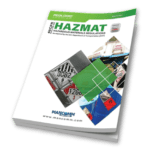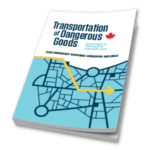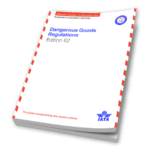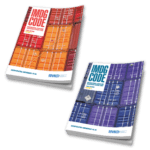
Shakespeare once said, “That which we call a rose, By any other name would smell as sweet.” Which is true, but unless you’re allergic to roses, misclassifying a rose as a violet isn’t a safety hazard. But when you’re dealing with dangerous goods, getting the right shipping name is essential.
What exactly is a shipping name? Well, in the dangerous goods system, it’s a name which can categorize a substance in a way that would be understandable to handlers and emergency responders. Trade names, which are usually selected by marketers, don’t normally give much guidance as to the hazards of a product, so shippers must assign a shipping name from a defined list in the regulation they’re shipping under. There are approximately 3500 names to choose from, though, so picking the right one takes some skill.
Shipping names were first developed in the United Nations Recommendations for the Transport of Dangerous Goods (UN Recommendations). This list is updated every two years, so some older names have been phased out. New names are introduced where needed, such as when new technology like lithium batteries are developed. Also, some regulations, such as the “Hazardous Materials Regulations” of 49 CFR, have supplemented the list with additional names which can be used if shipping under those regulations. That’s how we have odd names in 49 CFR, such as “Compounds, tree-killing liquid.”
Here’s how to go about selecting a shipping name for your product. Note that this is a generic plan based on the UN Recommendations. Consult the regulation you’re shipping under for full details.
Selecting a Specific Shipping Name
For common products with hazards that are consistent and well-known, the shipping name may simply be the substance or article name. You just need to go to the list of dangerous goods in the regulation you’re using. These include:
- The Hazardous Materials Table in 49 CFR
- Schedule 1 in Canada’s “Transportation of Dangerous Goods Regulations”
- The Dangerous Goods List, section 3.3 in the International Maritime Dangerous Goods Code (IMDG)
- The List of Dangerous Goods, section 4.2, in the IATA Dangerous Goods Regulations.
For example, the chemical toluene is assigned the name “Toluene,” and lithium-ion technology batteries are named “Lithium-ion batteries.” Finding shipping names for such products is pretty simple – you just go to the list of shipping names in each regulation and look them up. Note that some regulations list the shipping names alphabetically in their tables, while some do it numerically. Those that use the numerical system will have a cross-reference table in alphabetical order after the main table. Then the list will assign the rest of the description (identification number, hazard class, and packing group, if any).
Don’t forget that many chemicals have a number of synonyms. If, for example, you look up “methylene dichloride,” you won’t find it listed, but the synonym “dichloromethane” will give you a hit as a specific shipping name. Abbreviations such as HCl for hydrochloric acid, or trade names such as “muriatic acid” also don’t show up as shipping names, so you may have to try a few different options if the first one doesn’t succeed. Sometimes a synonym may appear on the list to direct you to the correct shipping name, but this isn’t guaranteed.
If your substance is listed by name but has been diluted with non-dangerous goods such as water, check to see if your substance still meets the criteria for the same class and packing group. If it does, you may use the specific shipping name with the words “mixture” or “solution” added. So, a solution of acetone in water that has the same class and packing group as pure acetone may be named “Acetone solution.”
When selecting your shipping name, watch out for “descriptive text.” This is text given in the list that isn’t meant to be part of the shipping name, but directions for how and when the particular entry is to be used. It’s usually indicated by being given in lower case text (in lists where the shipping name is given in upper case), as italics rather than as roman text (in 49 CFR), or in light type, rather than bold type in the IATA DGR. For example, in TDG and the IMDG Code, you’ll find the entry “RESIN SOLUTION, flammable.” The shipping name you want is “RESIN SOLUTION.” The word “flammable” is not part of the name, but restricts the use of this entry to resins which are flammable based on their flashpoints. Non-flammable resins wouldn’t use this entry and may not be dangerous goods at all unless they have some other hazard.
Selecting a Generic Shipping Name
But what if your product isn’t listed by name? This can happen if your product is a mixture of two or more dangerous goods, a newly-developed chemical, or simply a substance that isn’t shipped in large enough quantities to make establishing a specific shipping name viable. It doesn’t mean that your product isn’t dangerous goods, though. As long as the properties of the substance make it dangerous in any of the nine hazard classes, the subtree-killing stance will be regulated. So, you’ll have to start from the opposite end of the problem.
First, determine if your product is actually dangerous goods, by testing or analyzing it. For example, if you suspect it could be a flammable liquid, a flash point test will tell you for sure. Remember that many products may have more than one hazard, so you’ll have to examine it to see if it falls into other classes as well, such as toxic substance or corrosive. If it does, each regulation will have a table that will help you determine which is the primary (most important) hazard, and which is the subsidiary (less significant) hazard. Don’t forget to select the appropriate packing group as well, if one applies to your hazards.
Then, once you have your class and packing group, you must find a generic shipping name that matches your classification. You may find various names that might describe your product with different degrees of precision. Types of shipping names include:
- Shipping names that describe a chemical family, if not the precise chemical – For example, there is a family of chemicals called “ketones.” Some of these, such as acetone, have their own specific names, but others don’t. So, if you have one of these ketones without its own specific name, or if you have a mixture of ketones, you can use “Ketones, n.o.s.” to describe the substance. (“N.o.s.” stands for “not otherwise specified,” and indicates there isn’t a more specific name available on the list.)
- Shipping names describing general usage of the product – These are often found for products in common use, and for which just giving the product type would provide enough information for emergency responders or handlers. Common examples include “Paint,” “Adhesives,” or the above-mentioned “Compounds, tree killing, liquid.” An emergency responder called to a spill of adhesives would have a pretty good idea they’re dealing with a viscous liquid that starts out sticky but may harden over time.
- If all else fails, you can usually find a shipping name that just describes the hazards of the product – Names in this category include “Flammable liquid, n.o.s.” or “Corrosive solid, n.o.s.” They frequently (but not always) use the “n.o.s.” conclusion. If a product has more than one hazard, odds are you can find a shipping name that includes both of them. So, for example if you have a substance with a primary hazard of Class 3 and a subsidiary of Class 8, you would look for a name such as “Flammable liquid, corrosive, n.o.s.”
So, if multiple shipping names might describe your product, which one should you choose? Some regulations give more guidance than others, but in general you should search for the one that gives the most specific information. So, “Ketones, n.o.s.” would be more specific than “Flammable liquid, n.o.s.” because it indicates the general type of chemical in the substance, rather than just the class. For emergency responders, this information can be useful. Ketones, for example, are usually what the chemists call “polar solvents.” They would be more soluble in water than, say, a substance named “Hydrocarbons, liquid, n.o.s.” Hydrocarbons are generally water-insoluble.
Adding Technical Names
Of course, many generic names, particularly those that end in “n.o.s.” will also require the addition of what are called “technical names.” The “n.o.s.” ending isn’t actually the key to when you need these names, incidentally. Most regulations will use a special provision to indicate when technical names are required (such as the IMDG Code’s Special Provision 274, or Special Provision 16 in TDG), or a special symbol assigned to the name, such as the asterisk in the IATA Dangerous Goods Regulations or the “G” in 49 CFR.
Technical names indicate the main hazardous ingredients in the substance. Most regulations based on the UN Recommendations require the listing of one technical name if there is only one dangerous ingredient and the two most significant ingredients if there is more than one. Canada is a little different in requiring “at least one” for all situations in TDG Special Provision 16.
Technical names, when required, will be marked adjacent to the shipping name on the package and after the shipping name itself on the shipping document. They are placed in parentheses to distinguish them from the actual shipping name. So, if you see “Flammable liquid n.o.s. (acetone, toluene),” you know that acetone and toluene are not separate products in the package, but ingredients in the one substance named Flammable liquid, n.o.s.
Other Issues in Selecting Shipping Names
When selecting shipping names, you’ll notice that some indicate that the material is “organic” or “inorganic.” For example, if you’re selecting a hazard-based name for a toxic liquid, you’ll have to choose between “Toxic liquid, organic, n.o.s.” and “Toxic liquid, inorganic, n.o.s.” What’s the difference? Well, organic chemicals are those with structures based on carbon and hydrogen atoms linked together, such as acetone (which has three carbons in its structure, along with hydrogen and oxygen) or pentane (which has five carbons as well as hydrogen). Inorganic chemicals, as you may guess, do not have any such carbon-hydrogen links in their structure. The relevance for transportation safety is that organic chemicals are usually more easily absorbed into the body. Skin contact with the chemical mercury, which is inorganic, doesn’t result in much immediate absorption, while contact with an organic chemical that contains mercury atoms can lead to significant absorption before the chemical can be cleaned off. So, all things considered, “Toxic liquid, organic, n.o.s.” will require more caution by emergency responders.
When looking for the ideal generic name, it may be hard to find the best one right away – after all, there are over a thousand, and many aren’t obvious. For example, if you have a solid substance not listed by name, but testing indicates it belongs in Division 4.3, Substances which, in contact with water, emit flammable gases, what is a suitable shipping name? “Substances which, in contact with water, emit flammable gases, n.o.s.” doesn’t exist, nor does “Dangerous when wet, n.o.s.” But if you have access to the IATA Dangerous Goods Regulations for air, you’re in luck. In Table 4.1.A, they list “generic and n.o.s. proper shipping names,” helpful arranged by class. Under the heading for Division 4.3, we find that the basic generic hazard-based name is “Water-reactive solid, n.o.s.” That’s not obvious at first glance, and this list can save you a lot of time. Unfortunately, for some reason, this table doesn’t contain the product use-type shipping names such as paint, but those tend to be more well-known by classifiers.
Don’t forget to look for shipping names that can address special problems. Shipping several different chemicals in one package by air? Use the name “Chemical kit” or “Consumer commodity,” and you won’t have to worry about the dreaded Q-value calculation. Shipping machinery that contains dangerous goods you can’t easily remove? “Dangerous goods in machinery” solves your problem. Unless the dangerous substance is mercury, in which case “Mercury contained in manufactured articles” will be a better solution, or batteries, which can be dealt with as “Battery-powered equipment.”
If you’re not familiar with dangerous goods classification, selecting the shipping name can be a difficult task. ICC Compliance Center can help you with your classification issues. Contact us here at 888-442-9628 (U.S.) or 888-977-4834 (Canada), and ask for one of our regulatory specialists.
Sources:
UN Recommendations on the Transport of Dangerous Goods, Rev. 21 (2019)
Title 49, Code of Federal Regulations, Hazardous Materials Regulations
Transportation of Dangerous Goods Regulations
Stay up to date and sign up for our newsletter!
We have all the products, services and training you need to ensure your staff is properly trained and informed.
 US 49 CFR Publications |
 Canadian TDG Publications |
 IATA Publications |
 IMDG Publications |






 ICC USA
ICC USA ICC Canada
ICC Canada